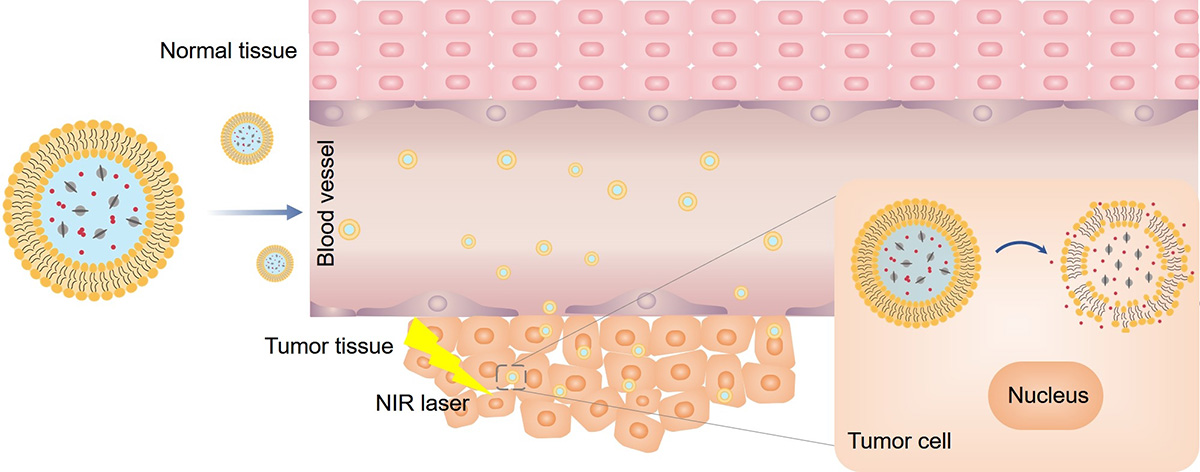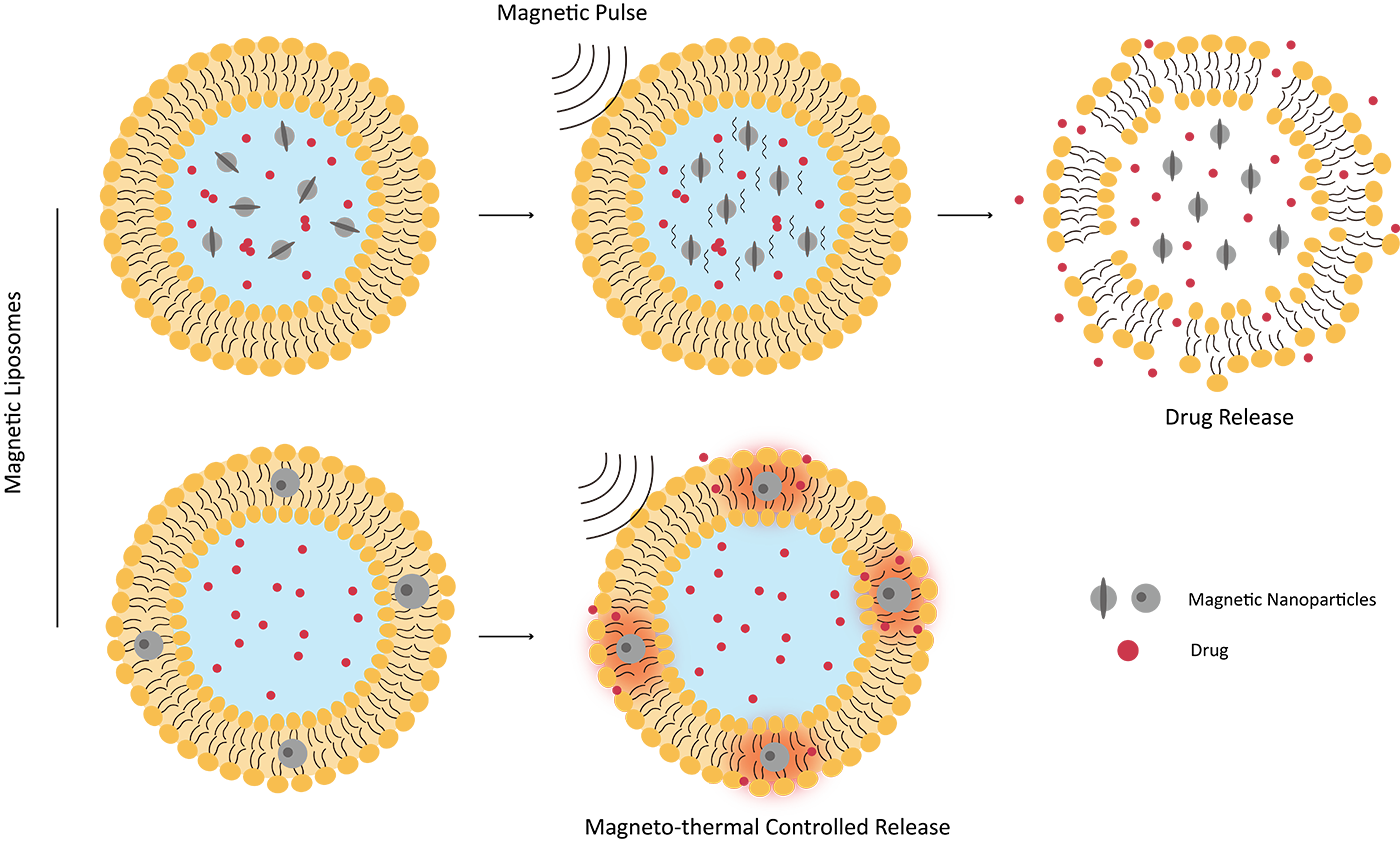Magnetic liposomes have revolutionized drug delivery systems by combining the unique properties of liposomes and magnetic nanoparticles. This allows for precise, targeted therapeutic applications. These versatile nanocarriers are used in a variety of fields, including drug delivery, imaging, and theranostics. Creative Biolabs, a leading expert in biotechnology solutions, offers comprehensive services to develop customized magnetic liposome formulations tailored to meet therapeutical research needs.
The successful development of a magnetic liposome-based drug delivery system depends on multiple factors. Several key strategies are employed to optimize liposome formulations for maximum efficiency:
Creative Biolabs utilizes these strategies to develop customized magnetic liposome formulations, optimizing each step for specific applications.
 Fig. 1 Near-infrared-triggered drug release from the magnetic liposome.
Fig. 1 Near-infrared-triggered drug release from the magnetic liposome.
Creative Biolabs provides a broad range of services aimed at optimizing and customizing magnetic liposome formulations for various pharmaceutical and research purposes. Below is an overview of key services offered:
| Service Aspect | Details | Customization Options |
| Custom Liposome Formulation | Tailors lipid composition, size, and surface modifications to meet specific project needs. | Lipid choice, PEGylation, size (50 nm - 200 nm), surface modifications. |
| Magnetic Nanoparticle Integration | Incorporation of superparamagnetic nanoparticles for precise targeting and enhanced imaging. | Iron oxide nanoparticles, magnetic field response adjustments. |
| Encapsulation Efficiency Optimization | Ensures high drug encapsulation rates while maintaining stability. | Varies by drug type and target, customizable encapsulation protocols. |
| Controlled Release Mechanisms | Designs liposomes that respond to external stimuli like magnetic fields, temperature, or pH variations. | Triggered drug release by magnetic field, temperature, pH, or NIR stimuli. |
| Sterility and Stability Testing | Prepares all liposome formulations under sterile conditions and tests for long-term stability. | Sterile conditions, stability in different storage buffers (pH 7.4 PBS). |
| Buffer Options | Customizes liposome buffer to suit specific project requirements. | Phosphate Buffered Saline (pH 7.4) or client-specified buffer. |
| Size Customization | Offers liposome size customization based on the application. | Standard sizes: 50 nm, 100 nm, 200 nm. |
Creative Biolabs thoroughly researches the physical, chemical, and pharmaceutical properties of the magnetic nanoparticles within the liposomes to optimize formulation performance. This ensures that all client needs are met to the greatest extent possible. For more detailed information, please feel free to contact us.
Magnetic liposomes are lipid-based vesicles that encapsulate magnetic nanoparticles, such as iron oxide, within their lipid bilayer or aqueous core. This combination merges the biocompatibility and drug-carrying capabilities of liposomes with the magnetic properties of nanoparticles. Magnetic nanoparticles allow the liposomes to be directed to specific sites within the body using an external magnetic field, enabling targeted drug delivery while minimizing systemic exposure.
The lipid bilayer of the liposome serves as a protective carrier for therapeutic agents such as drugs or proteins, shielding them from degradation in the bloodstream. Magnetic liposomes are particularly useful in localized treatments like cancer therapy, where targeted drug delivery is essential. Moreover, magnetic nanoparticles enhance imaging capabilities, such as in MRI, making magnetic liposomes a valuable tool in theranostics. Additionally, the controlled release of drugs from magnetic liposomes can be triggered by external stimuli, such as magnetic fields, heat, or pH changes. This feature enhances treatment precision and minimizes adverse side effects.
 Fig. 2 Structure of magnetic liposome.
Fig. 2 Structure of magnetic liposome.
Magnetic liposomes can be broadly categorized into two types: non-PEGylated and PEGylated. The primary distinction between these formulations is the surface modification of the liposome with polyethylene glycol (PEG), which affects circulation time and immune recognition.
| Feature | Non-PEGylated Magnetic Liposomes | PEGylated Magnetic Liposomes |
| Lipid Composition |
Cholesterol DSPE-DTPA-Gd DSPC |
Cholesterol DMPE-DTPA-Gd DPPC PEG (2000) |
| Molar Ratio |
30% Cholesterol 25% DSPE-DTPA-Gd 45% DSPC |
33% Cholesterol 25% DMPE-DTPA-Gd 37% DPPC 5% PEG |
| Liposome Size | 100 nm (customizable to 50-200 nm) | |
| Buffer | Phosphate Buffered Saline (pH 7.4) | |
| Advantages |
High Drug Encapsulation Shorter Circulation |
Extended Circulation Time Reduced Immune Clearance |
Non-PEGylated magnetic liposomes are often favored for faster drug release, making them ideal for treatments requiring short circulation times. On the other hand, PEGylated liposomes are designed for extended circulation, making them suitable for treatments where longer-lasting effects are needed.
Magnetic liposomes offer significant advantages in targeted therapy, particularly in the treatment of cancers and other localized diseases. By leveraging the magnetic properties of these liposomes, drugs can be delivered directly to the target area, reducing off-target effects and enhancing therapeutic outcomes.
The use of an external magnetic field allows precise localization and retention of the liposomes at the target site. This feature is especially beneficial in cancer treatments, where chemotherapy drugs can be directed to tumors, minimizing damage to healthy tissues. In addition, by altering the magnetic field or applying other external stimuli, such as near-infrared (NIR) radiation, the release of the encapsulated drug can be controlled, providing a more precise treatment approach.
 For Research Use Only. Not For Clinical Use
For Research Use Only. Not For Clinical UseServices
Online Inquiry

